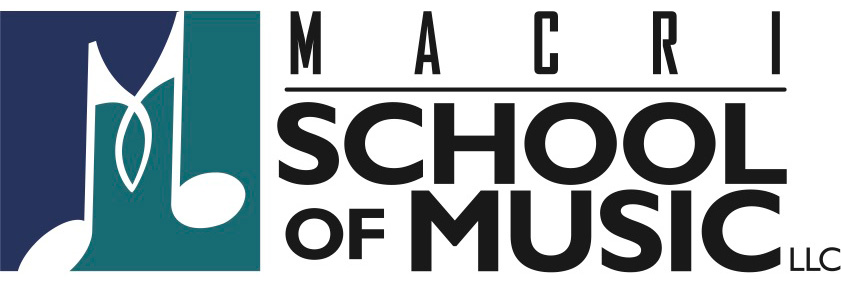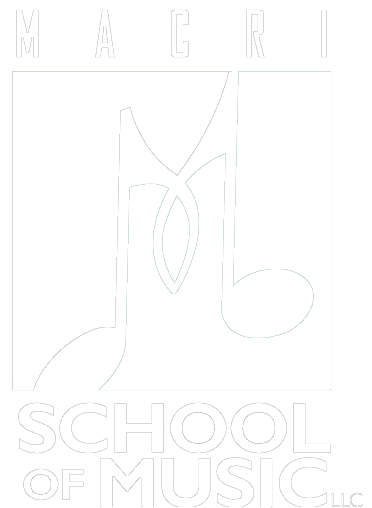Country Guitar Primer Pt. 1
What constitutes country music these days certainly warrants a discussion. What isn’t up for debate, is the fact that country music of all eras features some of the best guitar playing one could ever hope to hear. From the fingerpicking mastery of Chet Atkins, to the chicken pickin of Albert Lee, to the pyrotechnics of Brad Paisley, country guitar has something all fans of the instrument can dig into. The country guitar genre is so vast, one could be confused as to where to begin. It’s like saying – “I want to learn rock!” This lesson will cover some basic concepts to get you going, and in future installments we will dig deeper into specific licks and styles.
The first area to cover is basic open position chords. Chances are most of you know these, but what might be new to you is some traditional country rhythm guitar patterns.
Ex.1 is a Carter family inspired rhythm in the Key of C. The bass notes tend to fall on the strong beats (1 & 3 ) while the higher notes of the chord ( melody & harmony ) fall on the weak beats (2 & 4).

Ex.2 is an expansion of that idea with an alternating bass pattern. This is known as the “Boom Chuck” rhythm and you’ll recognize this sound in many songs by the legendary Johnny Cash.
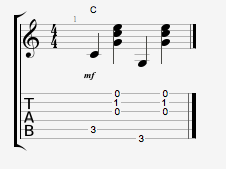
Ex.3 adds some more bass notes to connect the chords together in a I-IV-V progression in the Key of C ( C-F-G). I have also added some 8th note strums to the treble strings to make the accompaniment more lively.

Ex.4 illustrates the Gmajor pentatonic scale in the open pos. The open strings give this scale more of a country flavor. Much of the country guitar language is major, but it often features minor scales, chromaticism, passing tones, flat 5’s and the combining of major & minor pentatonic scales. You will notice that the notes in Gmajor pentatonic are the same as Em Pentatonic, Em is the relative minor of Gmajor. To find the relative minor of a major key, simply count down a minor 3rd from the tonic. E & G are 1 1/2 steps apart from one another.
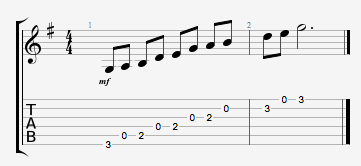
Ex.5 can be analyzed in a few different ways. It is the Gmaj pentatonic scale with a b3 added to it, (Bb), played in the open position (G,A,Bb,B,D,E). You will also recognize it as the E blues scale, and it might be something you have played before, but maybe in a blues context. So in Gmaj, drop down a minor 3rd and play the blues scale built off the relative minor (Em), or play the major pentatonic with a b3 added to it built off the tonic (G). This is a sound very common in country guitar as well as southern rock. If you play over a I-IV-V in G, this scale will work over all three chords and you’ll instantly get that country vibe. One area of tension to watch out for is the G played over the V chord (D or D7), this note needs resolution but if the chord moves down a whole step the progression will provide that release. This concept of playing the relative minor off the major is very important to grasp, it needs to be automatic so that it becomes intuitive.
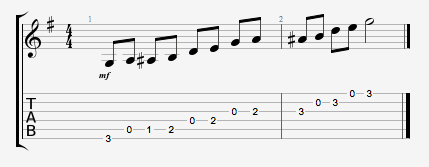
Ex.6 is a classic bluegrass inspired pattern that we will play in G. It utilizes the Gmajor pentatonic with b3 / E blues scale, and it’s moveable so play it in all 12 keys to get comfortable with. It starts on the root and moves up a whole step, then you play the 2nd, b3, and 3rd. The 5th & 6th are played on the next string and then the pattern repeats itself. The fingering is the same on every string group, except you have to move up a half step between the 3rd and 2nd string. This is a great lick to get under your fingers and it sounds flashy when you get it up to a quick tempo.

Hopefully these musical examples and simple concepts will get you off and running into the exciting and challenging world of country guitar. The next lesson will focus on some of the cool bends found in this genre, (double stops, pedal steel bends, oblique bends, etc.) Happy pickin!
